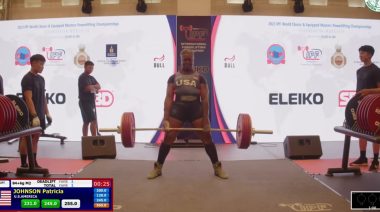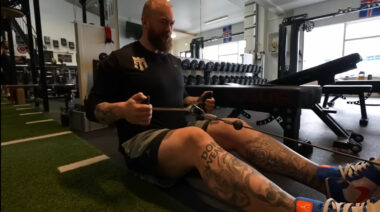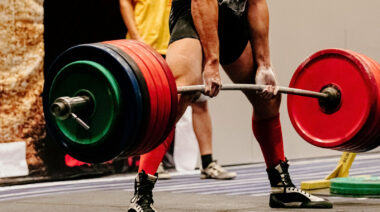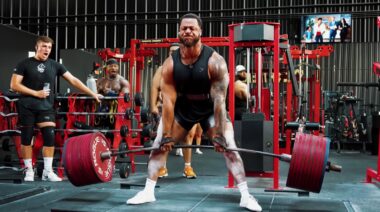Note: Charles is here on a weekly basis to help you cut through the B.S. and get to the bottom of the biggest questions in health and training. Post your questions via social media or in the comments section below to participate in next week’s mailbag.
Question #1: Ye Olde Butt Wink
READER: If my butt winks when I squat but nothing hurts as a result, should I just keep doing squats until my butt doesn’t wink anymore? Or should I actively try to fix the wink and avoid squatting?
CHARLES SAYS: Just for those who may not recognize the term, “butt wink” refers to lumbar flexion while squatting – or put another way, when your low back “rounds” toward the bottom of the squat. The problem with lumbar flexion is that it’s not as safe as maintaining a neutral spine, particularly if you have existing spinal issues.
So with all that in mind, what causes butt wink and how can we rid ourselves of it?
It used to be commonly thought that short hamstrings were a major culprit, but this probably isn’t the case, since for most people, squatting doesn’t really cause a net change in hamstring length, because even though the hamstring does shorten at the hip when you squat, it also simultaneously lengthens at the knee.
Another possible cause is an inadequate conceptual understanding of proper lumbar position during the squat. In other words, you might not understand the correct position and how to obtain it.
“[M]ake a list of the eight to twelve movements you consider to be important to your development, and do them (or versions of them) every single week.”
With those two possibilities aside, the most likely cause of butt wink for most lifters is hip structure. For some people, the head of the femur jams up against the hip socket at some point during the descent of the squat. From that position, if you wish to squat even deeper, the spine must compensate to provide movement the hip can no longer provide.
My default position on this issue is that you should maintain a neutral spine during squatting. Therefore, only squat as deep as you’re able to maintain this position, and if you find you need additional leg work, use other exercises for that purpose (leg extensions, leg curls, RDLs, etc.)
Question #2: Commercial Gym Challenges
READER: Every time I’m at the gym and trying to do my workout, there’s always some piece of equipment that is occupied when I need it. Is it better to do the next movement and come back to whatever I can’t do now or wait until the programmed equipment and movement are available?
CHARLES SAYS: This is a common issue in commercial gyms, but one that can usually be solved or at least mitigated proactively. Here are a few strategies you can use to do just that:
- Wherever possible, program exercises that your gym has multiple stations for. In other words, if you gym only has one reverse hyper but four leg curl stations, you might program leg curls instead of reverse hypers.
- Instead of having hard-and-fast exercise menus, have two options for each muscle you want to train. For example, maybe on Mondays your first exercise is either squats or leg presses. It may be that you prefer squats, but have leg presses as a plan B in case the squat racks are occupied when you need them.
- Choose your gym carefully, and consider having two or three gym options available for different workouts. If you like doing Olympic lifts, for example, choose a gym that has plenty of lifting platforms, bumper plates, and so on.
- If you normally bench as the first exercise in your workout, but the benches are all occupied when you get to the gym (imagine that!), do your second or third planned movement first and then bench press a bit later when a station has opened up.
Question #3: Gains and Program Structure
READER: How do I know when to switch routines? When the gains stop? When I get bored? After twelve weeks? Why are routines twelve weeks long, anyway?
CHARLES SAYS: I actually never change all, or even most of my program elements simultaneously. Instead, I might change, modify, or delete an exercise here and there as my needs change, and/or modify the set-and-rep bracket of one or more exercises periodically. But for me, if an exercise is important, I never change it per se.
As an example, I’ve been deadlifting at least once a week for at least four years now. Same for squats. Sure, I’ll make modifications to the type of deadlifts and squats I do (block pulls, box squats, and so on), but I always do these movements. The idea of changing your program every twelve weeks is primarily a marketing gimmick designed to target beginners or people with poor resolve and who have difficulty sticking to anything for more than a few months at a time.
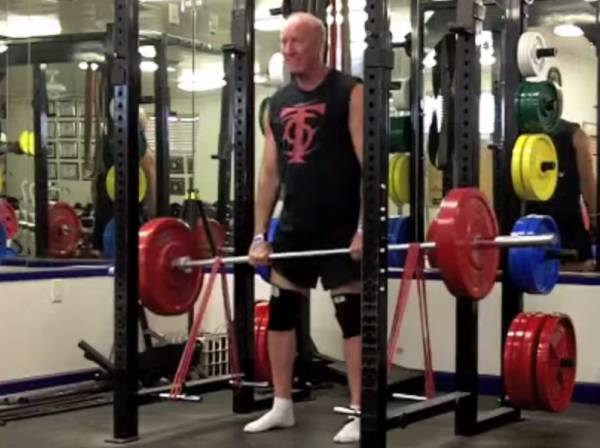
So my advice is, make a list of the eight to twelve movements you consider to be important to your development, and do them (or versions of them) every single week. If, on occasion, you come to the conclusion that one or more of these movements are no longer in your best interests, then sure, remove it or replace it with something else.
If you suddenly come to the conclusion that you’d like to replace your whole-body workouts with upper/lower split, that’s fine too, but I don’t consider this an entirely new program, just a modification of what you were already doing.
Bottom line: get out of the mindset that your entire program should be changed on a regular basis, because it shouldn’t.
This Week’s Training
Weekly Training Volume: 73,919 Pounds (Last Week 67,677 Pounds)
Significant Lifts:
- Low Bar Squat: 335×2
- Deadlift Against Bands: 335×1
- Deadlift: 445×1
- Military Press: 143×1
The thing that most jumps out at me this week is my training volume, which – at over 73,000 pounds – is the highest it’s ever been since I started tracking this data point regularly. And it certainly doesn’t seem to be at the expense of intensity either. I’ve been pulling over 450 every single week, have hit some very good singles in the bench and military press recently, and overall, all my numbers seem to be on track.
“I … never change all, or even most of my program elements simultaneously.”
I was telling a friend that I’ve been reading some articles about the optimal training of older athletes, and honestly, my own training doesn’t exactly correspond with those recommendations. For example, I’ve been consistently doing 1.5 to 2.5 hour workouts four times a week for several years now, and I’ve been deadlifting twice a week for several months at this point.
Of course, the counterargument is that perhaps a lower-frequency approach would work even better, but it doesn’t seem to be the case, at least for me.
That’s all for this week. Please watch the video of Thursday’s session, and as always, I love hearing your comments and taking your questions. Please post them to the comments below.
Monday, February 9, 2015
Bodyweight: 200.4 lbs
Volume: 20,200 Pounds
Average Weight Per Rep: 143.26
Power Snatch
- Set 1: 45 lbs × 5
- Set 2: 45 lbs × 5
- Set 3: 66 lbs × 5
- Set 4: 66 lbs × 5
- Set 5: 88 lbs × 3
- Set 6: 99 lbs × 3
- Set 7: 110 lbs × 3
- Set 8: 121 lbs × 2
- Set 9: 132 lbs × 2
- Set 10: 143 lbs × 1
- Set 11: 154 lbs × 1
- Set 12: 154 lbs × 1
- Set 13: 132 lbs × 2
- Set 14: 132 lbs × 2
- Set 15: 132 lbs × 2
Notes: IQ: 89.28
Squat
- Set 1: 45 lbs × 5
- Set 2: 95 lbs × 5
- Set 3: 135 lbs × 5
- Set 4: 185 lbs × 3
- Set 5: 225 lbs × 2
- Set 6: 275 lbs × 2
- Set 7: 315 lbs × 2
- Set 8: 335 lbs × 2
- Set 9: 275 lbs × 5
- Set 10: 225 lbs × 10
Notes: IQ: 191.58
- Set 1: 315 lbs × 7
- Set 2: 315 lbs × 6
Notes: IQ: 315
45° Back Extension
- Set 1: 100 lbs × 15
- Set 2: 100 lbs × 15
- Set 3: 100 lbs × 15
Notes: IQ: 100
Tuesday, February 10, 2015
Bodyweight: 199.4 lbs
Volume: 19,511 Pounds
Average Weight Per Rep: 127.51
Bench Press
- Set 1: 45 lbs × 10
- Set 2: 95 lbs × 10
- Set 3: 135 lbs × 8
- Set 4: 185 lbs × 5
- Set 5: 205 lbs × 3
- Set 6: 225 lbs × 3
- Set 7: 245 lbs × 2
- Set 8: 255 lbs × 1
- Set 9: 225 lbs × 5
- Set 10: 205 lbs × 7
Notes: IQ: 148.14
Military Press
- Set 1: 45 lbs × 10
- Set 2: 65 lbs × 10
- Set 3: 85 lbs × 10
- Set 4: 105 lbs × 5
- Set 5: 105 lbs × 7
Notes: IQ: 76.42
- Set 1: 6 reps
- Set 2: 6 reps
- Set 3: 6 reps
- Set 4: 6 reps
- Set 5: 8 reps
Notes: IQ: 199.4
- Set 1: 80 lbs × 8
- Set 2: 80 lbs × 8
- Set 3: 80 lbs × 8
Notes: IQ: 80
Thursday, February 12, 2015
Bodyweight: 201 lbs
Volume: 19,125 Pounds
Average Weight Per Rep: 205.64
Clean and Jerk
- Set 1: 45 lbs × 5
- Set 2: 45 lbs × 5
- Set 3: 65 lbs × 3
- Set 4: 65 lbs × 3
- Set 5: 95 lbs × 2
- Set 6: 115 lbs × 1
- Set 7: 135 lbs × 1
- Set 8: 165 lbs × 1
- Set 9: 175 lbs × 1
Notes: IQ: 73.63
Deadlift Against Bands
- Set 1: 135 lbs × 3
- Set 2: 135 lbs × 3
- Set 3: 185 lbs × 3
- Set 4: 225 lbs × 3
- Set 5: 275 lbs × 3
- Set 6: 315 lbs × 1
- Set 7: 335 lbs × 1
Notes: IQ: 206.76
Deadlift
- Set 1: 455 lbs × 1
Notes: IQ: 455
Safety Squat
- Set 1: 65 lbs × 8
- Set 2: 155 lbs × 6
- Set 3: 205 lbs × 5
- Set 4: 245 lbs × 4
Notes: IQ: 150.21
Back Extension
- Set 1: +135 lbs × 17
- Set 2: +135 lbs × 13
Notes: IQ: 135
Video of this entire session with commentary below:
Saturday, February 14, 2015
Bodyweight: 201 lbs
Volume: 15,083 Pounds
Average Weight Per Rep: 120.66
Military Press
- Set 1: 44 lbs × 10
- Set 2: 66 lbs × 8
- Set 3: 88 lbs × 6
- Set 4: 110 lbs × 4
- Set 5: 132 lbs × 2
- Set 6: 143 lbs × 1
- Set 7: 110 lbs × 6
Notes: IQ: 81.16
Bench Press (Dumbbell)
- Set 1: 120 lbs × 8
- Set 2: 160 lbs × 8
- Set 3: 180 lbs × 8
- Set 4: 180 lbs × 8
- Set 5: 180 lbs × 8
Notes: IQ: 164
Seated Row
- Set 1: 150 lbs × 8
- Set 2: 150 lbs × 8
- Set 3: 150 lbs × 8
Notes: IQ: 150
Bicep Curl (Dumbbell)
- Set 1: 80 lbs × 8
- Set 2: 80 lbs × 8
- Set 3: 80 lbs × 8
Notes: IQ: 80
Check out these related articles:
- More From the Smart Strength Mailbag
- Strength and Conditioning Workouts by Charles
- What Your Butt-Winking Dog Squat Is Doing to Your Poor Knees
- What’s New On Pulse Beat Fit Today

